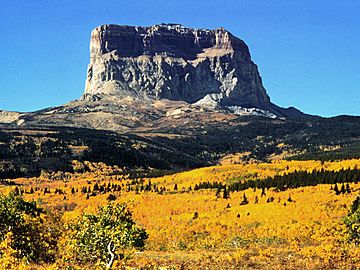Chief Mountain facts for kids
Quick facts for kids Chief Mountain |
|
|---|---|

Chief Mountain
|
|
| Highest point | |
| Elevation | 9,085 ft (2,769 m) NAVD 88 |
| Prominence | 1,840 ft (560 m) |
| Geography | |
| Location | Glacier County, Montana, U.S. |
| Parent range | Lewis Range |
| Topo map | USGS Chief Mountain, MT |
| Climbing | |
| First ascent | 1892 by Stimson, et al. |
| Easiest route | Scramble |
Chief Mountain (in the Blackfoot language called Ninaistako) is a striking peak in Montana, United States. It stands tall on the eastern border of Glacier National Park and the Blackfeet Indian Reservation. This mountain is one of the most noticeable peaks along the Rocky Mountain Front. This front is a long line of mountains formed by a special type of fault called the Lewis Overthrust. This fault stretches from central Montana all the way into southern Alberta, Canada.
Contents
What Makes Chief Mountain Special?
Chief Mountain is easy to spot from both Montana and Alberta. This is because it rises very quickly, about 5,000-foot (1,500 m), from the flat Great Plains right next to it.
How Chief Mountain Formed
Chief Mountain is a great example of something called a klippe. Imagine a very old block of rock that has been pushed on top of much younger rocks. That's what happened here! The top of Chief Mountain is made of Precambrian rocks, which are about 600 million years old. These old rocks sit right on top of younger Cretaceous gray shales. The younger rocks at the base are 400 to 500 million years newer than the rocks above them.
This happens because of thrust faults, where older rock layers slide over younger ones. The Lewis Overthrust is a huge example of this. Over time, erosion has worn away the surrounding rock, leaving Chief Mountain as an isolated piece of this ancient rock.
Chief Mountain's Many Names
For hundreds of years, Chief Mountain has been a sacred place for Native American tribes. The Blackfoot people call it Nínaiistáko.
History of the Name
European explorers first saw the mountain in the late 1700s. On maps from the United Kingdom in 1795, it was known as "Kings Peak." Later in the 1800s, its name changed to "Chief Mountain." This new name reflected how the Blackfeet people called it "Great Chief." When Glacier National Park was created in 1910, the mountain's top and most of its eastern side became part of the park. Only the lower parts remained within the Blackfeet territory.
A Sacred Place
Chief Mountain is still very important to many First Nations people in both the U.S. and Canada. People from all over North America visit the mountain's base. They hold special ceremonies, like sweet grass ceremonies, and place prayer flags. These are important religious traditions.
In the early 1900s, when more settlers came to the area, they saw Native American burial sites around the mountain's base. Elders from groups like the Siksika Band in Southern Alberta (where the famous Great Chief Crowfoot came from) have old stories. These stories talk about the mountain's future and its spiritual significance.
Climbing Chief Mountain
The eastern side of Chief Mountain is very steep, rising over 1,500 ft (460 m) straight up. The easiest way to climb this side is considered a "class 4" climb by mountaineers. This means it's quite difficult and often requires using your hands. The rock is mostly sedimentary, which can make it hard to find good places to secure ropes. This adds to the challenge.
First Climbers
The first known climb by non-Native explorers was on September 8, 1892. Henry Stimson and two other explorers, including a Blackfeet Indian, successfully climbed the tough eastern face. When they reached the top, they found ceremonial items, like bison skulls. These had been left by Native Americans. The eastern face was not successfully climbed again until 1951.
While you can reach the top from the west, it's usually easier to start from the east. To cross the Blackfeet reservation lands, you might need a special permit from the Blackfeet tribe. Remember, this entire area is very sacred to the Blackfeet Native Americans. You can find more information at the National Park Service visitor centers in St. Mary, Montana and at Many Glacier.
See also
 In Spanish: Monte Chief para niños
In Spanish: Monte Chief para niños



